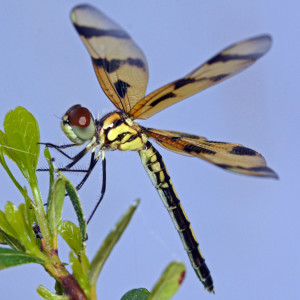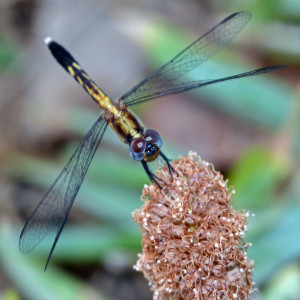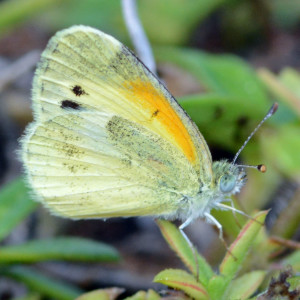April’s showers have brought an explosion of new insect life to the garden. This morning I went out to check on the new plantings (record heat yesterday had made me concerned despite the relatively frequent recent rains) and discovered at least a half dozen Halloween Pennant dragonflies:

Three or four little blue dragonlets (yes, this one isn’t blue; they aren’t when they’re relatively fresh males or, if they’re females, they’re this color throughout life):

And a new butterfly species for the yard. (I’m sure it’s been here every spring; this is just the first time I’ve been able to document it.) It’s a small yellow butterfly with a name that pretty much says the same thing: Dainty Sulphur.

It’s the smallest North American pierid (the term for butterflies in this family, “whites and yellows” or “whites and sulphurs”). They feed on low-growing plants in the Asteraceae, which basically means they feed on weeds. Around here they like Spanish Needles and perhaps other herbs in the genus Bidens, so there’s very little reason to fear for the future of this weedeater. No one, and I mean no one, can get rid of Spanish Needles. (Glassberg, though, describes the status of this butterfly as “uncommon to abundant, decreasing immigrant northward and westward.”)
The taxonomic name is Nathalis iole, which translates roughly to “Nathalie’s purple.” I actually have no idea what the derivation of Nathalis is, so I speculate it honors someone Boisduval, who named the species, knew or fancied. The specific epithet, iole, though, comes from the Greek “ion” (ἰόν), which can mean either “violet,” for the faint purple flush that is sometimes present on this butterfly (the caterpillar actually has two purple stripes on it), or “ion,” the term Michael Faraday invented in 1834 to describe how something “goes” (from the Greek past participle of “to go,” which is another meaning of ἰόν) from one electrode to another through an aqueous medium. (Boisduval names the species in 1836, so “ion” might have been in the current, so to speak.)
References
“Attributes of Nathalis iole.” Butterflies and Moths of North America (website). http://www.butterfliesandmoths.org/species/Nathalis-iole
Glassberg, J. (2012). A Swift Guide to Butterflies of North America. Morristown, NJ: Sunstreak.
Minno, M. Butler, J., and Hall, D. (2005). Florida Butterfly Caterpillars and their Host Plants. Gainesville: U of Florida P.
The dreaded Wikipedia for Faraday’s coining of the term “ion.”
